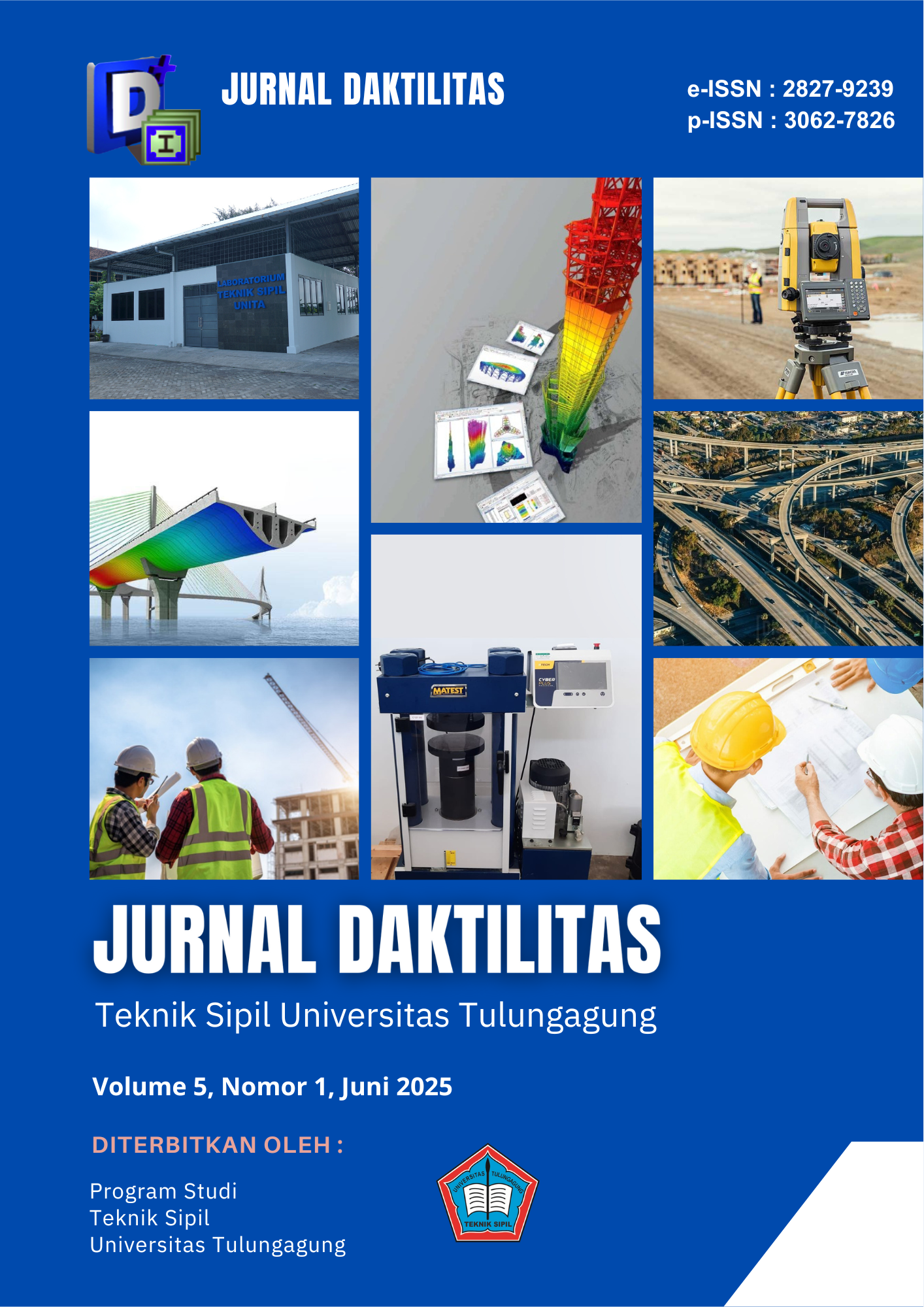INOVASI DESAIN PONDASI CAKAR AYAM UNTUK STRUKTUR BANGUNAN BERTINGKAT DI DAERAH GEMPA
DOI:
https://doi.org/10.36563/daktilitas.v5i1.1640Keywords:
Pondasi cakar ayam, tanah lunak, respons seismik, kapasitas dukung, efisiensi konstruksi, daerah rawan gempa, material inovatifAbstract
Abstract
Chicken claw foundations have proven to be an effective solution in increasing the stability of building structures, especially in areas with soft soil conditions and a high risk of earthquakes. Hardiyatmo's research (2015) shows that this system is able to increase the bearing capacity of the soil by up to 35% through optimizing the stiffness of the foundation plate so that it is suitable for application in infrastructure projects on problematic soil. Meanwhile, Prakoso and Kumara (2018) revealed that the chicken claw foundation design can reduce the earthquake response of multi-storey buildings by up to 20% and increase construction cost efficiency by 15% compared to conventional methods. Material innovation is also an important factor, as found by Kusuma and Hidayat (2020) who show that the use of high quality concrete and geotextiles is able to optimize bearing capacity and withstand deformation due to earthquakes up to 25% better than standard materials. These studies confirm that chicken claw foundations are an adaptive and economical alternative for earthquake-prone areas with challenging soil conditions
Keywords: Chicken claw foundation, soft soil, seismic response, bearing capacity, construction efficiency, innovative materials, earthquake prone areas
Abstrak
Pondasi cakar ayam terbukti menjadi solusi efektif dalam meningkatkan stabilitas struktur bangunan, terutama pada daerah dengan kondisi tanah lunak dan resiko gempa tinggi. Penelitian Hardiyatmo (2015) menunjukkan bahwa sistem ini mampu meningkatkan daya dukung tanah hingga 35% melalui optimalisasi kekakuan pelat pondasi sehingga cocok diterapkan pada proyek infrastruktur pada tanah bermasalah. Sedangkan Prakoso dan Kumara (2018) mengungkapkan bahwa desain pondasi cakar ayam dapat menurunkan respon gempa gedung bertingkat hingga 20% dan meningkatkan efisiensi biaya konstruksi sebesar 15% dibandingkan dengan metode konvensional. Inovasi material juga menjadi faktor penting, seperti yang ditemukan oleh Kusuma dan Hidayat (2020) yang menunjukkan bahwa penggunaan beton dan geotekstil berkualitas tinggi mampu mengoptimalkan daya dukung dan menahan deformasi akibat gempa hingga 25% lebih baik dibandingkan material standar. Studi-studi ini menegaskan bahwa pondasi cakar ayam merupakan alternatif yang adaptif dan ekonomis untuk daerah rawan gempa dengan kondisi tanah yang menantang.
Kata kunci: Pondasi cakar ayam, tanah lunak, respons seismik, kapasitas dukung, efisiensi konstruksi, material inovatif, daerah rawan gempa
Downloads
References
Hardiyatmo, H. (2015). Pengaruh Pondasi Cakar Ayam terhadap Peningkatan Kapasitas Dukung Tanah. Jurnal Geoteknik Indonesia, 10(2), 45-57.
Kriswardhana, A., & Sari, R. (2020). Pengembangan Sistem Base Isolation untuk Infrastruktur di Wilayah Seismik. Seminar Nasional Teknik Sipil, Yogyakarta, 87-99.
Kusuma, R., & Hidayat, S. (2020). Inovasi Material dalam Desain Pondasi Cakar Ayam. Jurnal Konstruksi dan Material, 18(3), 115-128.
Prakoso, B., & Kumara, D. (2018). Analisis Respon Seismik Gedung Bertingkat dengan Pondasi Cakar Ayam. Jurnal Teknik Sipil Universitas Indonesia, 22(1), 30-45.
Downloads
Published
Issue
Section
License
Authors who publish with this journal agree to the following terms:
- Copyright on any article is retained by the author(s).
- The author grants the journal, right of first publication with the work simultaneously licensed under a Creative Commons Attribution License that allows others to share the work with an acknowledgment of the work’s authorship and initial publication in this journal.
- Authors are able to enter into separate, additional contractual arrangements for the non-exclusive distribution of the journal’s published version of the work (e.g., post it to an institutional repository or publish it in a book), with an acknowledgment of its initial publication in this journal.
- Authors are permitted and encouraged to post their work online (e.g., in institutional repositories or on their website) prior to and during the submission process, as it can lead to productive exchanges, as well as earlier and greater citation of published work.
- The article and any associated published material is distributed under the Creative Commons Attribution-ShareAlike 4.0 International License
Deprecated: json_decode(): Passing null to parameter #1 ($json) of type string is deprecated in /home/journal.unita.ac.id/public_html/plugins/generic/citations/CitationsPlugin.php on line 68






